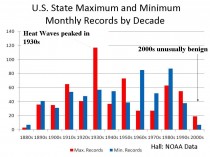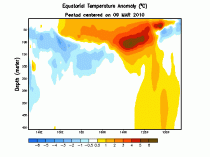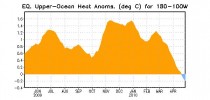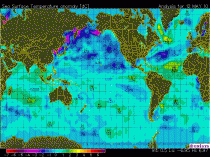May 20, 2010
Malaria in retreat despite warmer climate
By Michael Marshall, New Scientist
IN A rare instance of humans beating one of the impacts of climate change, measures to combat malaria appear to be neutralising the expected global increase of the disease driven by rising temperatures.
Peter Gething of the University of Oxford compared a map of the range of malaria in 2007 with one from 1900, when the world was 0.7 C cooler. He found the proportion of Earth’s landmass where malaria is endemic has fallen from 58 per cent to 30 per cent (Nature, vol 465, p 342). Malaria’s rate of transmission has also fallen almost everywhere.
This indicates that the incidence of malaria may not rise as a result of climate change. “The things acting to reduce malaria spread, like improved healthcare and disease control, are much more powerful than the weak effect of warming,” Gething says.
That doesn’t mean health authorities can rest on their laurels. Kevin Lafferty, an ecologist at the US Geological Survey, says the positive global picture hides shifting regional ones. Malaria is expected to move to different areas, even as its overall range decreases, he says.
May 19, 2010
Scientist Disputes EPA Finding that Carbon Dioxide Poses Threat to Humans
By Gene J. Koprowski
EPA scientists say manmade carbon dioxide and other greenhouse gases are contributing to a warming of the global climate—and as such represent a threat to human welfare. But a leading climatologist says his research indicates that CO2 poses no threat to human welfare at all, and he says the EPA should revisit its findings.
CHICAGO—Carbon dioxide is hazardous to your health, the Environmental Protection Agency says. Oh really?
EPA scientists say manmade carbon dioxide and other greenhouse gases are contributing to a warming of the global climate—and as such represent a threat to human welfare. Officials went so far as to declare the gas a danger to mankind in early December. But a leading climatologist says his research indicates that CO2 poses no threat to human welfare at all, and he says the EPA should revisit its findings.
“There is an overestimation of the environment’s sensitivity to CO2,” said Dr. Patrick Michaels, senior fellow in environmental studies at the CATO Institute and a past president of the American Association of State Climatologists.
Michaels spoke before a group of about 700 scientists and government officials at the fourth International Conference on Climate Change. The conference is presented annually in Chicago by the Heartland Institute, a conservative nonprofit think tank that actively questions the theory of man’s role in global warming. Last year the Institute published Climate Change Reconsidered, a comprehensive reply to the United Nations’ latest report on climate change.
Michaels described how the U.N. gathers weather information for its computer models, on which the EPA based its ruling. He said data gathering at weather stations in some parts of the world is spotty, and U.N. scientists add new figures to compensate. But in doing so, he said, they also add errors to the final research product.
“There is a systemic bias in the computer models,” said Michaels, whose research suggests that the U.N.’s adjusted computer modeling data, rather than actual observed data, is what connects the rise in temperatures to manmade causes. When one takes away the computerized modeling enhancements, he said, mankind’s contribution to global warming is virtually nil, approximately .03 degrees, rather than .07 degrees, over the last 50 years.
Thus, he said, most of the planet’s warming is not from manmade sources. “This idea that most of the warming is due to greenhouse gases caused by man just isn’t right,” he said.
But Catherine C. Milbourn, a spokeswoman for the EPA in Washington, disagreed with Michaels’ conclusions. “The U.S. Supreme Court ruled three years ago that greenhouse gas emissions constitute air pollution, and EPA set out to determine whether that pollution threatens the health and welfare of Americans,” she told FoxNews.com, explaining that the EPA ruling was based on a comprehensive review of available science from an array of peer-reviewed sources across the globe.
“The conclusion: The scientific evidence of climate change is overwhelming, and greenhouse gases pose a real threat to the American people. The question of the science is settled,” Milbourn said.
Greg Wiles, an associate professor of geology at The College of Wooster in Ohio, agreed with Milbourn. “Despite the recent attacks on the scientific community and large-scale buy-in by some of the public, the science behind the conclusion that contemporary warming is largely anthropogenic (manmade) still stands,” he told FoxNews.com.
But others disagree. Former Virginia Gov. George Allen, chairman of the American Energy Freedom Center think tank, said that the U.S. is “at a crossroads in energy policy,” but that the country “cannot stand with pompous elites.” He noted that a bill has been introduced in the U.S. Senate to essentially veto the EPA’s “endangerment finding”—and he said that others, like the legislature of the state of Kansas, have also gone on record against implementing an energy policy based on EPA’s findings. Read story here.
May 15, 2010
Questions posed for Kerry, Lieberman on new climate-energy bill
By Paul Driessen and Dr. Willie Soon
The new Kerry-Lieberman climate bill mandates a 17% reduction in US carbon dioxide emissions by 2020. It first targets power plants that provide reliable, affordable electricity for American homes, schools, hospitals, offices and factories. Six years later, it further hobbles the manufacturing sector itself.
Like the House-passed climate bill, Kerry-Lieberman also requires an 83% reduction in CO2 emissions by 2050. Once population growth and transportation, communication and electrification technologies are taken into account, this translates into requiring US emission levels last seen around 1870!
House Speaker Pelosi says “every aspect of our lives must be subjected to an inventory,” to ensure that America achieves these emission mandates. This means replacing what is left of our free-market economy with an intrusive Green Nanny State, compelling us to switch to unreliable wind and solar power, and imposing skyrocketing energy costs on every company and citizen.
Meanwhile, the Environmental Protection Agency is implementing its own draconian energy restrictions, in case Congress does not enact punitive legislation.
It’s time to ask these politicians some fundamental questions.
1) Even slashing carbon dioxide emissions to 83% below 2005 levels would reduce projected global average temperatures in 2050 by barely 0.2 degrees F, according to a study that used the UN’s own climate models. That’s because China, India and other developing countries are building new coal-fired power plants every week, even as the United States and Europe shackle their economies and send more jobs overseas. How do you justify such destructive, punitive, meaningless legislation?
2) Reflecting agreement with thousands of scientists, most Americans now say climate change is natural, not manmade. Fully 75% are unwilling to spend more than $100 per year in higher energy bills to “stabilize” Earth’s unpredictable climate. What provision of the Constitution, your oath of office or your duty to the overall health and welfare of this nation permits you to ignore the will of the people, the mounting evidence that “climate disasters” are the product of manipulated data and falsified UN reports, and the job-killing impacts of the laws and regulations you seek to impose?
3) If carbon dioxide is causing “runaway global warming,” why have average global temperatures not risen since 1995, and why have they been COOLING for the past five years - even as atmospheric carbon dioxide levels have continued to rise to levels unprecedented in the modern era?
4) What properties does manmade carbon dioxide have that enable it to replace the complex natural forces that clearly caused the Ice Ages, Medieval Warm Period, Little Ice Age, Dust Bowl, ice-free Arctic seas in 1822 and 1922, Alaska’s 100 degree F temperature record in 1915, and all the other climate and weather changes and anomalies, blessings and disasters that our planet has experienced during its long geologic and recorded history?

State record highs (enlarged here) show the 1930s still dominates.
5) What physical or chemical properties does manmade carbon dioxide have that would enable it to overturn the laws of thermodynamics - and cause temperatures in Antarctica to rise 85 degrees F (from an average of minus 50 F to plus 35 F year-round, or 48 degrees C, from -46 C to +2 C), to melt that continent’s vast ice masses, raise sea levels 20 feet or more, and flood coastal cities?
6) Precisely what chemical, physical and thermodynamic processes would drastic carbon dioxide reductions alter, and how? Precisely what weather and climate improvements would those reductions achieve? Precisely how will CO2 reductions stabilize planetary temperature, climate and weather systems that have been turbulent, unpredictable and anything but stable throughout Earth’s history?
7) Is there ANY direct physical observation or evidence that would falsify your climate crisis thesis, and cause you to say human greenhouse gas emissions are not causing a planetary climate disaster? Or do you think everything that happens confirms your climate disaster hypothesis: warmer or colder, wetter or drier, more snow and ice or less, more hurricanes and tornadoes or cyclical periods with few such storms?
8) Replacing hydrocarbons with unreliable, subsidized “green” energy will require millions of acres of land for wind turbines, solar panels and transmission lines - plus hundreds of millions of tons of steel, copper, concrete, fiberglass and rare earth minerals for all those facilities.
Do you support delaying wind, solar and transmission projects for years, to protect the rights and property of local communities and private landowners? Or do you favor regulatory edicts and eminent domain actions, so that government can seize people’s property and expedite construction of these projects?
Do you support opening US public lands for renewed exploration and development, so that we can produce these raw materials and create American jobs? Or do you intend to keep US lands off limits, and force us to depend on imports for renewable energy, too?
Do you support relaxing environmental study, endangered species and other laws, to fast-track approval of these projects, despite their obvious impacts on wildlife and habitats? Or do you want them subjected to the same rules that have stymied thousands of other energy projects, so that renewable energy projects cannot be built, either - and we have massive blackouts?

9) Over 1.5 billion people in Africa, Asia and Latin America still do not have electricity, for even a light bulb or tiny refrigerator. Millions die every year from diseases that would be largely eradicated with electricity for refrigeration, sanitation, modern hospitals, and industries that generate greater health and prosperity. How can you justify using taxpayer money to finance UN and environmental activist programs that claim global warming is the biggest threat they face, and they need to get by on wind and solar power, and give up their dreams of better lives, because YOU are worried about global warming? Doesn’t that violate their most basic human rights to improved living standards, and even life itself?
10) If you’re so sure about your data and conclusions - and intend to use climate disaster claims to justify sending our energy costs skyrocketing, killing millions of factory jobs, controlling our lives, and totally overhauling our energy, economic and social structure - why do you refuse to allow fair, open and balanced congressional hearings and debates on climate science and economics? Why do you refuse to debate skeptical experts in a public forum, or even answer questions that challenge your alarmist thinking? Why do you refuse to require that scientists who get taxpayer money for their research must share and discuss climate data, computer codes, methodologies and analyses?
11) How much money and campaign help have you gotten from companies and activist groups that benefit from renewable energy mandates and subsidies, carbon offset and trading schemes, coal mining and oil leasing bans, and other provisions of climate and energy legislation?
12) What if you vote for these job-killing, anti-growth, anti-poor, anti-human-rights “climate disaster prevention” laws - and it turns our you are WRONG on the science or economics? What will you do? Give up your congressional seat, home, pension and worldly wealth - and pledge yourself and your children to an austere life of service to the people you have harmed? Or just say, “Oh I’m so sorry,” and then pass more intrusive, oppressive laws, before retiring to collect a nice government pension - while millions freeze jobless in the dark?
13) If you can’t or won’t answer these questions, then why do you think you have a right to tell anyone on this planet that we have a “climate crisis,” and dictate how they must live their lives - especially when you’ve done virtually nothing to slash your own air travel, staff, and home and office energy use?
Paul Driessen is senior policy advisor for the Committee For A Constructive Tomorrow and author of Eco-Imperialism: Green Power - Black Death. He has studied climate change for over 15 years.
May 14, 2010
IPCC Cites an Unpublished Journal 39 Times
By Donna Laframboise, Noconsensus
We read a lot of magazines in our house. Occasionally, an issue arrives in which nearly every article is engaging and (in the case of cooking magazines) every recipe sounds amazing. In short, the issue is a keeper.
The Intergovernmental Panel on Climate Change (IPCC) had an experience like that. It was so impressed by one edition of the academic journal Climatic Change that it cited 16 of the 21 papers published that month. The journal editors should take a bow. When three-quarters of a single issue of your publication is relied on by a Nobel-winning report, you’re doing something right.
Except for one small problem. The issue in question - May 2007 - didn’t exist yet when the IPCC wrote its report. Moreover, none of the research papers eventually published in that issue had been finalized prior to the IPCC’s cutoff date.
As the IPCC chairman recently reminded us, that organization’s 2007 report:
...was based on scientific studies completed before January 2006, and did not include later studies…
That’s what the rules say. And that’s what was supposed to have happened. But according to the online abstracts for each of the 16 papers cited by the IPCC and published in the May 2007 issue of Climatic Change (see my working notes here): 15 of them weren’t accepted by the journal until Oct. 17, 2006, the other wasn’t accepted until May 18, 2006.
The first date is highly significant. As the second box on this page makes clear, the IPCC expert review period ended on June 2, 2006 for Working Group 1 and on July 21, 2006 for Working Group 2. This means the expert reviewers had offered their comments on the second draft and had already exited the stage. It means the IPCC had reached the utmost end of a process that represented years of collective labour.
So how could 16 papers, accounting for 39 new citations across fours chapters and two working groups, have made it into this twice vetted, next-to-finalized IPCC report? Those citations don’t reference research papers the wider scientific community had already digested. They don’t even reference papers that were hot off the press. Instead, in 15 of 16 cases, no expert reviewer could possibly have evaluated these papers since they hadn’t yet been accepted for publication by the journal itself.
Where do these 39 citations of the May 2007 issue of Climatic Change turn up in the IPCC report? [working notes here]
Chapt. 11 by Working Group 1 references ten papers (20 citations in total)
Chapt. 12 by Working Group 2 references nine papers (15 citations in total)
Chapt. 2 by Working Group 2 references two papers (2 citations in total)
Chapt. 3 by Working Group 2 references two papers (2 citations in total)
Among the 10 papers cited in Chapter 11 three were co-authored by Jens Hesselbjerg Christensen. I’m sure it’s sheer coincidence that this gentleman served as one of two coordinating lead authors for that chapter.
see the first abstract here (cited twice as Jacob et al. 2007 on this page of the IPCC report)
second abstract is here (cited as Déqué et al. 2007 on this page)
third abstract is here (cited as Christensen et al. 2007 on this page)
I’m equally certain there’s no connection whatsoever between the fact that Jørgen E. Olesen was a lead author for the IPCC’s Chapter 12 and that a paper he co-authored in the May 2007 issue of Climatic Change got cited four times in that chapter. (That abstract is here. Cited as Olesen et al., 2007 four times on this page.)
Welcome to the strange world of the IPCC. Whenever one turns over a new rock there’s something shady beneath. See post here.
Coming soon: the research paper that wasn’t accepted for publication until May 2008, yet got cited seven times in the IPCC’s 2007 report
May 12, 2010
Ocean Acidification is New Climate Scare, Says SPPI
By Dennis Ambler on SPPI
ICECAP ASIDE:

El Nino dying rapidly. See equatorial Pacific cross section animation showing how lingering warm pool gets mixed out and cold expands. La Nina is coming. here.
See tropical Pacific heat content diminish rapidly below (enlarged here) in the last few months. Now colder than normal.

I can’t remember a North Pacific this cold (enlarged image from Unisys).

-----------------
SPPI Monthly CO2 Report
By Cristopher Monckton
Now updated through April here.
-------------------
Ocean Acidification is New Climate Scare, Says SPPI
By Dennis Ambler on SPPI
“Ocean acidification is the new climate scare,” writes Dennis Ambler in a recent paper for the Science and Public Policy Institute, a Washington D.C. non-profit research and education organization.
Ambler’s paper, Dying Shell Fish Larvae: The Story of a Scam, expands on the following points:
Ø Ocean acidification is the new climate scare and is being used as part of the “Climate Change” drive to force emissions legislation.
Ø Presentations to a Congressional hearing on “The Environmental and Economic Impacts of Ocean Acidification” claimed ocean acidification is “real” and that seawater is “corrosive” to shell fish larvae. This is a deliberate distortion; indeed it is a lie.
Ø IPCC AR4 WGI states that the mean pH of surface waters ranges between 7.9 and 8.3 in the open ocean, so the ocean remains alkaline. It is dishonest to present to a lay audience that any perceived reduction in alkalinity means the oceans are turning to acid.
Ø The oft-repeated claim that ocean “acidification” has increased by 30% since the Industrial Revolution is based on an average of a calculation, from an estimate of anthropogenic CO2 uptake by the oceans, from 1750 to 1994. It shows a decrease in alkalinity of 0.1pH unit, well within the range of current ocean pH quoted by IPCC AR4 WG1.
Ø Prominent scientists have claimed that high mortality rates in Oyster hatcheries operated in the North West Pacific, are due to “acid seawater” resulting from upwelling of the deep ocean. There is no acid seawater. As stated in AR4 WGI, the oceans are alkaline, not acid.
Ø Those same scientists stated that bacterial contamination of seawater was not to blame for the high oyster larvae mortality rates.
Ø Contrary to their false claims, the problem of early oyster mortality has been found to be directly caused by a faecal organism, Vibrio tubiashii. Research programs are currently underway to investigate the extent and resolution of the problem.
Ø This research is being conducted by the Pacific Shellfish Institute and was known at the time of the acid seawater claims.
Ø The fact that this was not considered or was even ignored, when the claims of “acid seas damage” were made, is at worst, mischievous and at best, very un-scientific.
The full paper can be read here.
Additional studies on the topic can be found here:
- CO2, Global Warming and Coral Reefs: Prospects for the Future

- Effects of Ocean Acidification on Marine Ecosystems
- Answers to a Fisherman’s Testimony about Ocean Acidification
- Acid Seas, Back to Basic
- A New Propaganda Film by Natl. Resources Defense Council Fails the Acid Test of Real World Data
- Calcification (Other Marine Organisms) - Summary
Contact: Robert Ferguson, Science and Public Policy Institute
202-288-5699
www.scienceandpublicpolicy.org
bferguson@sppinstitute.org
|








